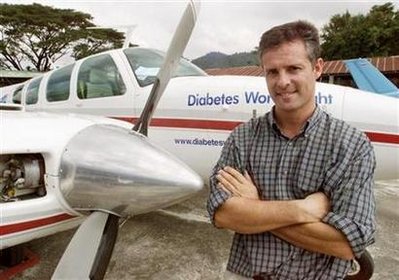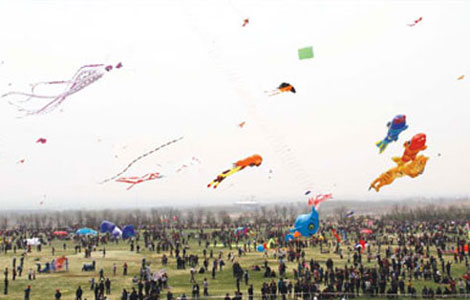Society
Diabetic completes first-ever polar flight of its kind
Updated: 2011-04-25 13:41
(Agencies)
|
 Former Royal Air Force fighter pilot Douglas Cairns poses with his Beech Baron twin engine plane at Bangpra airfield, east of Bangkok, in this December 8, 2002 file photo. [Photo/Agencies]
|
"It was rather surreal and very exhilarating to be at the crown of our Planet Earth with 24 hours of daylight," he said Friday in an Anchorage interview.
"I'm delighted to be able to do this kind of thing solo, with diabetes."
Cairns, 47, flew from Barrow, the northernmost community in the United States, to the North Pole on Tuesday in a Beechcraft Baron and completed the 1,300-mile flight in eight hours and 20 minutes.
He has submitted the time to the World Air Sports Federation for verification as a world speed record for a light, twin-engine piston aircraft. But the submission is largely academic because Cairns believes he is the first pilot to have made the trip in such an aircraft and to land it at the pole - a claim backed by a spokesman for Guinness World Records.
After circling the geographic pole several times, Cairns landed at a nearby Russian ice camp, making him the first to land a twin-engine piston aircraft at the pole.
He then flew home back to Barrow in six hours and 20 minutes, aided by strong tailwinds.
For part of the journey, he had to navigate using the sun's position in the sky because global positioning satellite equipment becomes unreliable near the North Slope.
The flight was one of a series of expeditions Cairns, who helped found an organization called Pilots with Diabetes, has completed to demonstrate ways to overcome limitations imposed by the disease.
Diagnosed with Type 1 diabetes in 1989, Cairns was forced to end his RAF flying career and go into finance.
But now, five nations allow insulin-treated diabetics to hold private pilots' licenses. One is the United States, which allows diabetics to fly solo so long as they adhere to regular in-flight monitoring of blood-sugar levels, with corrective actions taken if warranted.
After US authorities cleared diabetic pilots for flight in 1997, Cairns took to the skies again and has set various speed and distance records.
They include the first-ever around-the-world flight by a diabetic pilot in 2003 and a 50-state flight completed in 2010.
His North Pole expedition drew much interest in aviation-crazed Alaska. A veteran Alaska pilot, Ron Sheardown, has been on his support team for years. Alaska Airlines and Alaska-based Era Aviation provided hangar space. And Cairns and his plane were filmed for an appearance in a future episode of "Flying Wild Alaska," a Discovery Channel television series about Alaska bush pilots.
Next on Cairns' agenda is a planned speed record circumnavigation around the British coastline, a flight he intends to do in about 14 hours.
After that? "In the next few years, I would very much like to make a journey down to the South Pole," he said.
E-paper

Blowing in the wind
High-Flyers from around the world recently traveled to home of the kite for a very special event.
Preview of the coming issue
Image maker
Changing fortunes
Specials

Costly dream
Uninhabited havens up for lease but potential customers face wave of challenges in developing them.

Models gear up car sales
Beauty helps steer buyers as market accelerates.

Urban breathing space
City park at heart of Changchun positions itself as top tourism attraction
